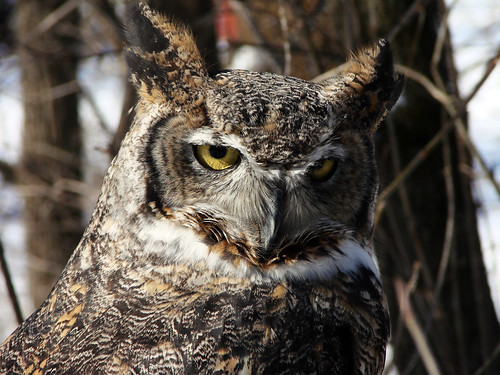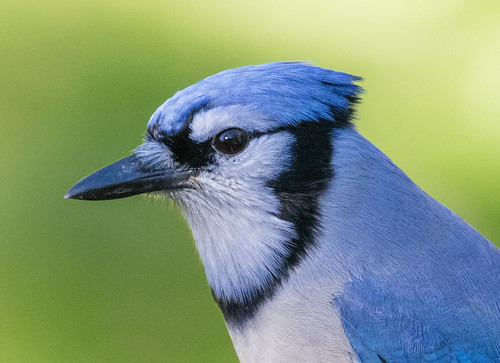Just as I got close, a couple of crows got closer than the owl wanted to deal with and it opened its great wings and flew off, the crows’ screams rising in a powerful crescendo.
Owls don’t like to fly long distances in daytime, and my neighborhood is old and established, with a great many huge trees, so I didn’t think the owl would go far. Sure enough, the commotion moved down just a couple of blocks. I walked over to find all the crows milling in a group of pine and spruce trees, complaining and seeming to be asking one another, “Which way did he go?”
The spunky little Blue Jay didn’t waste his time griping—he started investigating. The owl didn’t seem to be in the stand of trees the crows were in, so the jay flew to a spruce in the neighboring yard and started spiraling around it, working his wings as hard as a hummingbird as he scrutinized every limb.
I caught sight of the owl the moment the jay did—he was hunkered down near the top of the spruce, facing the trunk and not moving a muscle. His feathers ruffled a bit in the wind, but otherwise he held stock still. The jay let out a triumphant whoop, and the crows flew up on the attack again, but the owl’s camouflage worked more effectively against the crows. The first time they flew to the tree, none of them caught sight of the owl’s face, with the distinctive eyes and feather tufts, and after squawking a bit, they went back to their tree.
But the little Blue Jay clearly wanted to be taken more seriously by his bigger brethren, so down he went again, this time squawking his head off, and managed to get the owl to turn its head and look at him. A couple of crows noticed that and started yelling as they flew in. Now the whole flock ambushed the owl, but he apparently figured he was safer where he was than he’d be flying through the open trying to find another hiding place. So he turned his face in again and bided his time. After yelling a while, the crows finally gave up.
The jay had lost interest as soon as he succeeded in getting the big guys to take him seriously, and had already left. A few of the crows sat back down in the pine trees and gossiped while the rest disappeared.
I looked at the owl, but he was apparently not interested in having some sort of mystical communion of souls with me—he just wanted to be left alone and kept his face hidden. So I packed up my liberal good intentions and walked away, but not before I spotted the spunky little Blue Jay and watched him fly past the spruce tree, hovering and peeking in a moment to make sure the owl was staying put as the jay flew off to new adventures.
Throughout the rest of the day, every now and then I’d hear the crows suddenly start squawking again, always from the same spot. It’s tough to be an owl in broad daylight, and tough to be a crow in the dark. But if I was going to spend my earthly existence as one of the birds in the day’s drama, I’d pick the one who has the most fun in any situation—the Blue Jay.

